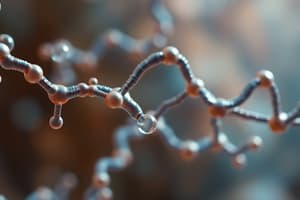Podcast
Questions and Answers
Which of the following techniques is NOT commonly used in proteomics and metabolomics?
Which of the following techniques is NOT commonly used in proteomics and metabolomics?
- Mass Spectrometry
- NMR Spectroscopy
- FTIR Spectroscopy
- X-ray Diffraction (correct)
What is the main focus of study in proteomics?
What is the main focus of study in proteomics?
- The complete set of proteins expressed by an organism (correct)
- The structure and function of individual proteins
- The interactions between proteins and other molecules
- The metabolic pathways involved in protein synthesis
Which of the following is NOT a benefit of using NMR spectroscopy in metabolomics?
Which of the following is NOT a benefit of using NMR spectroscopy in metabolomics?
- High sensitivity for detecting low-abundance metabolites (correct)
- Provides information on metabolite structure and dynamics
- Widely applicable to a variety of biological samples
- Non-destructive analysis, allowing for repeated measurements
What type of information can be obtained from FTIR spectroscopy in metabolomics?
What type of information can be obtained from FTIR spectroscopy in metabolomics?
Which of the following is an application of proteomics in crop improvement?
Which of the following is an application of proteomics in crop improvement?
What is the primary focus of proteomics?
What is the primary focus of proteomics?
Which of the following is NOT a major application of proteomics?
Which of the following is NOT a major application of proteomics?
What is the main advantage of using NMR spectroscopy in metabolomics?
What is the main advantage of using NMR spectroscopy in metabolomics?
Which of these factors can influence the metabolic profile of an organism?
Which of these factors can influence the metabolic profile of an organism?
What is the main difference between proteomics and metabolomics?
What is the main difference between proteomics and metabolomics?
What is the main goal of drug discovery using proteomics?
What is the main goal of drug discovery using proteomics?
How does FTIR spectroscopy contribute to metabolomics research?
How does FTIR spectroscopy contribute to metabolomics research?
What is the purpose of using biomarkers in metabolomics?
What is the purpose of using biomarkers in metabolomics?
In the context of proteomics, what are protein modifications such as phosphorylation and glycosylation important for?
In the context of proteomics, what are protein modifications such as phosphorylation and glycosylation important for?
Which of the following is NOT a common application of metabolomics in agriculture?
Which of the following is NOT a common application of metabolomics in agriculture?
Flashcards
Proteomics
Proteomics
The study of the entire set of proteins expressed in a cell, tissue, or organism.
Metabolomics
Metabolomics
The analysis of metabolic processes and the set of metabolites present in a biological sample.
NMR Spectroscopy
NMR Spectroscopy
A technique used to observe the local magnetic fields around atomic nuclei, useful in metabolomics.
Applications of Proteomics
Applications of Proteomics
Signup and view all the flashcards
FTIR Spectroscopy
FTIR Spectroscopy
Signup and view all the flashcards
Protein Interaction
Protein Interaction
Signup and view all the flashcards
Applications of Metabolomics
Applications of Metabolomics
Signup and view all the flashcards
Biomarkers
Biomarkers
Signup and view all the flashcards
Cell Cycle
Cell Cycle
Signup and view all the flashcards
Carcinogenesis
Carcinogenesis
Signup and view all the flashcards
Signup and view all the flashcards
Study Notes
Proteomics and Metabolomics
- Proteomics is the study of proteins
- It identifies the number of proteins in an organism that may differ from cell to cell over time
- Focuses on changes due to mRNA phosphorylation and glycosylation
- Variations occur due to cell development, cellular differentiation, cell cycle, or carcinogenesis (biomarker)
- Applications include bioinformatics, agriculture, protein interaction, biomarker, protein structure, characterizing brain cells at a molecular level, and neurotoxicology
Metabolomics
- Study of substrates and products of metabolism affected by genetic and environmental factors
- Molecules involved include sugars, lipids, amino acids, fatty acids, phenolic compounds, and alkaloids
- Interactions rapidly change over time
- Molecules are continuously absorbed, synthesized, degraded, and interact with other molecules
Methods of Measurement
- NMR (Nuclear Magnetic Resonance) Spectroscopy: used for measuring metabolite concentration and structure
- FTIR (Fourier Transform Infrared) Spectroscopy: used to identify the structure of chemical molecules
Proteomics Applications
- Biomedical applications: pharmaceutical, preventive healthcare
- Agriculture applications: improving genetic traits of plants, biomarker identification (possible customized treatment)
Proteomics and Drug Discovery
- Target identification and selection
- Target isolation and purification
- Structure determination
- Analyzing structure for potential ligand binding sites
- Docking of small molecules using computational methods
- Biochemical assays and further testing
- Lead optimization to improve potency
- Cytotoxicity tests, pharmacokinetic studies, and toxicological investigations
Studying That Suits You
Use AI to generate personalized quizzes and flashcards to suit your learning preferences.




